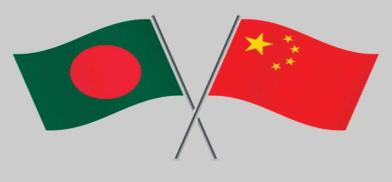Bangladesh can gain by taking part in Chinese trade fairs
Like Bangladesh, South Asian countries can use Chinese expos to promote their brands and build a new trade image

South Asian countries today confront challenges of economic vulnerability as a result of Covid-19, climate change and geopolitical rivalry posed by emerging military groupings. Simultaneously, a rising trend of trade protectionism with new hidden barriers and de-globalization in the global market are restricting the economic and investment sectors’ ability to promote global trade sustainably.
In this context, China’s open door and cooperation policy offer a glimmer of hope for the region's prosperity and development, resuming economic growth at a faster rate. In order to fulfill President Xi Jinping's pledge to turn the Chinese market into a world market, Beijing has taken a number of steps, including one that lets foreign enterprises greater access to the domestic market and a foreign investment law that ensures a business-friendly environment.
At the same time, China has taken steps to strengthen bilateral, multilateral and regional cooperation by joining trade blocs such as the Regional Comprehensive Economic Partnership (RCEP) and the Comprehensive and Progressive Agreement for Trans-Pacific Partnership (CPTPP), hosting a series of mega trade exhibitions and improving connectivity through the Belt and Road Initiative (BRI).
Chinese expos
Of them, the China Import and Export Exhibition (Canton Fair), China International Import Expo (CIIE), China International Fair for Trade in Services (CIFTIS), China-ASEAN Expo, China-South Asia Expo, Euro-Asia Economic Forum and Trade Cooperation Expo, Inter-Textile Shanghai Apparel Fabrics and China Yangling Agricultural High-tech Fair are key exhibitions that will undoubtedly be of great significance to developing economies like Bangladesh. It is expected that Bangladeshi participation in these forums will open vistas of business opportunities and further enhance bilateral relations and cooperation.
According to data, from January to July 2021, the overall import and export volume of China and Bangladesh was $13 billion, a rise of 58.9 percent year on year. Though bilateral trade favors China heavily, Bangladesh has enormous potential that has yet to be realized. Dr. M.A. Razzaque, Head of Research and Policy Integration for Development (RAPID), conducted research that shows Bangladesh can earn $25 billion if it grabs just a 1 percent share of China’s imports.
China-Bangladesh trade
China imported goods worth $2.4 trillion in 2019-20 and Bangladesh’s share was very insignificant (0.05%). In the next decade, China is expected to import $22 trillion worth of goods. Hence, China’s Expo platform will provide a great opportunity for Bangladesh to explore the vast Chinese market and expand exports to bridge the bilateral trade gap and increase revenue.
Bangladesh’s major export items, including readymade garments, leather goods, jute and jute goods, agricultural products, frozen and live fish, pharmaceutical products, plastic, sports goods, handicrafts and tea have strong exports destination (mainly the US and EU) might put Bangladesh in a more challenging position.
The US has suspended GSP for Bangladesh in June 2013 and India imposed anti-dumping duty on Bangladeshi jute goods in January 2017. There is no guarantee to get into the EU’s GSP+ scheme on expiry of the EBA initiative after graduation from the LDC group in 2026.
Amid such economic uncertainty, the good news is that China has provided duty-free access to 97 percent of Bangladeshi products (8,256 products) from July 2020. The expos are important ways to learn about Chinese consumer preferences and to tap into the vast China market. By taking part in these expos, Bangladesh can display and popularize its flagship products and diversify its export destination globally as a large number of buyers, entrepreneurs and companies from Europe, America, Australia, Southeast Asia, Middle East and Africa attend these. The China-ASEAN Expo (CAEXPO) can give Bangladesh trilateral trade expansion opportunity to enter China and the ASEAN market which has a combined population of 2 billion and a GDP of $18.5 trillion.
Chinese market prospects
Bangladesh’s development-first strategy, low-cost and skilled labour market, appealing geostrategic location as well as investment-friendly policies make it an ideal investment destination. Bangladesh needs to highlight the vast investment potential and create confidence in a large number of foreign investors. Dhaka is building high-quality infrastructure, such as power plants, bridges, highways, railways and ports, in collaboration with China. The Bangabandhu Bangladesh-China Friendship Exhibition Center has opened in Dhaka to host fairs, aiming at reaching its products to new global markets.
The expos offer a platform to understand the Chinese market and China's development as well as to make new linkage with consumers, companies, experts and different technologies which could lead to product specialization and value addition. China is a market with 1.4 billion people and over 400 million middle-income people. China can provide technical assistance in framing policy positions and export-development strategies to help Bangladeshi products reach the Chinese market.
Like Bangladesh, South Asian countries can also use Chinese expos to promote their brands, build a new trade image and expand business opportunities in China and the worldwide market.
(The author is a development worker and a writer on development issues in international affairs. The views expressed are personal. He can be contacted at psbhuiyan92@gmail.com)












Post a Comment